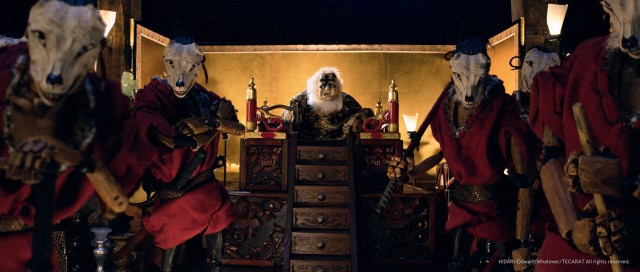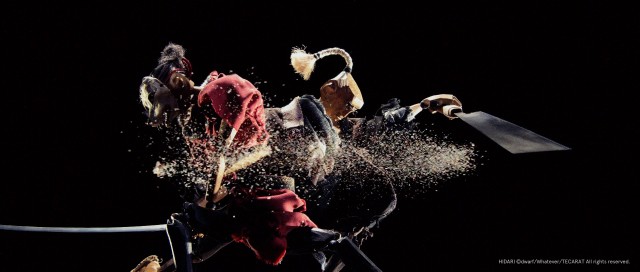Proof of concept shorts created to help raise funds for feature adaptation aren’t really our raison d’etre here on Short of the Week, but when they’re as good as Masashi Kawamura and Iku Ogawa’s stop-motion Hidari, they’re impossible to ignore. A six-minute tale of a vengeful sculptor with a mechanical prosthetic arm, Hidari is a contemporary take on a Japanese legend, brought to life with jaw-dropping craft.
Introducing viewers to its titular protagonist as he faces up to one of his sworn enemies and former disciples, Inumaru, we witness this legendary sculptor dispose of numerous henchmen, with just one hand, before revealing his prosthetic appendage to take the action up another level. When he ditches his giant wooden fist, after it gets caught in an opponents chain, a quick whistle to his faithful cat and he’s presented with a new attachment (a chainsaw – Bruce Campbell style) from his toolbox. If that’s not enough to have you hooked, wait to see how Inumaru reacts. The film ends on a cliffhanger moment, but if like me you’re hungry for more, lets make sure we get that feature funded.

Inumaru and a selection of his finest masked henchmen ready for action.
Fascinated with stop-motion from an early age, filmmaker Kawamura came up with the premise for Hidari when brainstorming ideas for a collaboration with Noriko Matsumoto, a producer at Dwarf Studios (Mogu & Perol). “Although many works attributed to Jingoro Hidari still exist, such as the ‘Sleeping Cat’ at the Nikko Toshogu Shrine, the character himself is shrouded in mystery and his existence is unknown, which I found very intriguing (similar to the mysterious street artist Banksy)”, the director explains. “In Rakugo and Koudan, traditional Japanese storytelling art forms, Jingoro Hidari is often portrayed as a woodcarver whose carved animals come to life, which reminded me of stop-motion animation, where life is breathed into inanimate objects”.
With this thought in mind, Kawamura established that stop-motion would be the perfect medium for his story and decided to create a Jidaigeki (Samurai film) based around the legend of this enigmatic artist. With Hidari’s carved sculptures in mind, the decision to use wooden puppets felt like the natural path to follow and from here Hidari’s distinct aesthetic began, with Kawamura revealing he had the “image of sawdust spewing out instead of blood when characters are slashed”.
Described as “Japanimation meets stop-motion” by its team, the short’s slick, action-packed visuals are one of its main selling points. Essentially one long fight sequence, the stop-motion footage and the edit had to be razor sharp to land its killer blow on its audience and it really doesn’t disappoint. Some of the most exciting stop-motion we’ve seen in a while, the kinetic camera movements and constant changes of pace are truly exhilarating.

The blood/sawdust effect is painstaking added to the short through practical FX work.
Once the idea to employ wood throughout the production was agreed, the Hidari team reached out to Takeshi Yashiro of TECARAT (Gon, the Little Fox) to use his experience of carving wooden puppets in their production. Putting this wooden style at the forefront of their vision, the animators sacrificed flexibility and designed the characters so that joints and chisel marks are visible throughout, heightening the effect. Even the blood splatter effect is created physically, with Kawamura and his crew shooting 50 plates of sawdusts being blown on a black backdrop to composite into scenes. You can learn more about Yashiro’s puppets and the film’s production in this insightful behind the scenes video.
Shot over 30 days and edited for two months, Hidari instantly has the feel of a future cult classic. The characters and craft will appeal to both fans of martial arts films and animation aficionados alike, with both (and many more) joining the hundreds of backers already eager for more on Kickstarter. I’ve already backed it myself, as I can’t stand to think this is the last I’ll ever see of this one-handed badass sculptor.

 Rob Munday
Rob Munday